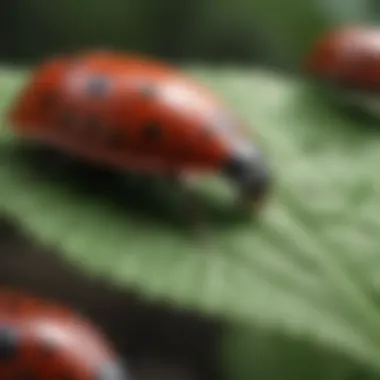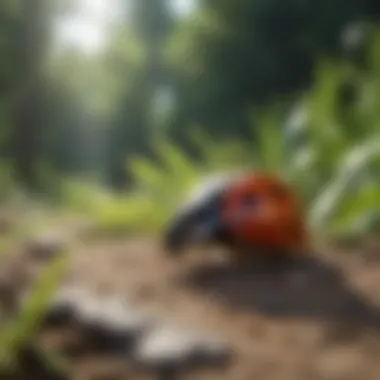Effective Methods for Managing Ladybug Populations


Intro
Managing ladybug populations in home settings can be a challenge for many homeowners. These small insects, while generally regarded as beneficial due to their pest-controlling nature, can become a nuisance when they invade indoor spaces. Understanding how to manage their presence effectively is essential. This article explores diverse techniques for controlling ladybug numbers, emphasizing natural, chemical, and preventative methods. Readers will gain insights into ladybug behavior and learn targeted strategies to maintain a comfortable living environment.
Key Insights and Trends
Current Trends in Pest Management
In recent years, there has been a shift towards more sustainable and eco-friendly pest management techniques. Homeowners now prioritize methods that minimize environmental impact and promote biodiversity. Many are moving away from chemical solutions, opting for natural alternatives to manage ladybug populations. This trend reflects a growing awareness of the importance of maintaining healthy ecosystems, even within urban settings.
Gardening Techniques of the Season
The gardening community is buzzing with new techniques that indirectly affect ladybug populations. Integrated pest management practices are gaining traction. This includes creating habitats that attract ladybugs while keeping them managed. Companion planting, for example, involves growing specific plants together that naturally deter pests, which in turn keeps ladybug populations in check without harmful chemicals. Popular plants for this technique include marigolds and garlic, both known for their repellent properties against many insect pests.
Practical Tips and How-To Guides
Step-by-Step Guides for Home Management
When faced with a ladybug invasion, homeowners can follow these systematic steps to regain control:
- Identification: Recognize the difference between native ladybugs and invasive species. Native species are often more beneficial.
- Sealing Entry Points: Inspect windows, doors, and vents to find and seal any cracks or gaps that may allow ladybugs to enter.
- Vacuuming: Gently vacuum ladybugs that have entered the home. This method is effective for immediate removal without harming them.
- Natural Deterrents: Employ natural repellents like essential oils or vinegar solutions around entry points.
- Create a Balanced Environment: Encourage natural predators and maintain a biodiversity-friendly garden.
Preventative Measures for Homeowners
Practical prevention is key to avoiding future ladybug problems. Consider the following methods:
- Maintain Cleanliness: Regularly clean your home, reducing clutter where ladybugs can hide.
- Monitor Outdoor Spaces: Keep an eye on your garden for signs of ladybug larvae. Early intervention can help manage populations.
- Educate Yourself: Learn about the beneficial roles of ladybugs in your garden to find a balance between maintenance and coexistence.
"Understanding the natural behaviors and cycles of ladybugs can empower homeowners to manage their spaces effectively."
Using these strategies, homeowners can strike a balance between appreciating the ecological benefits of ladybugs and controlling their populations. This approach fosters a more harmonious relationship between the home environment and the natural world.
Prolusion to Ladybugs
Understanding ladybugs can significantly influence how homeowners approach pest management. These insects, often regarded as beneficial, can become nuisance pests if not properly controlled. Awareness of their behavior and ecological role forms the foundation for effective population management.
Ladybugs, commonly known for their distinctive red and black coloration, play dual roles in the ecosystem. While they contribute positively by controlling aphid populations, their sudden presence indoors can lead to frustration for homeowners. This article dives deep into ladybug management strategies, providing insightful methods to balance their beneficial aspects against the desire for a peaceful living environment.
Understanding Ladybug Behavior
Ladybugs exhibit specific behaviors that are crucial to understand for effective control. Primarily, they seek shelter during colder months, which often leads them to invade homes in search of warmth. In particular, the multicolored Asian lady beetle species is known for this behavior.
Recognizing these patterns helps homeowners anticipate infestations. Ladybugs tend to cluster in secluded areas such as attics or under eaves. By observing their seasonal patterns, effective preemptive measures can be adopted. Simple actions like sealing potential entry points around windows and doors can deter them from entering.
Moreover, ladybugs are attracted to light colors, making bright home exteriors a possible attractant. Reducing light sources near suspected entry points can help mitigate this attraction.
The Role of Ladybugs in Ecosystems


Ladybugs are pivotal in their natural habitats, serving as voracious predators to various pests, particularly aphids. This predation supports agricultural health and biodiversity. For gardeners, ladybugs often symbolize a natural method of pest control, reducing the need for chemical interventions.
However, their ecological value does not entirely eliminate concerns about their presence in homes. When ladybugs congregate indoors, they can create inconvenience. Thus, understanding their ecological role aids homeowners in evaluating the balance between fostering beneficial species and managing unwanted populations.
In summary, familiarity with ladybug behavior and their ecosystems paves the way for effective management strategies. This foundational knowledge encourages a more balanced approach, recognizing the ladybug's positive contributions while addressing the challenges they pose when entering our homes.
Reasons for Ladybug Infestations
Understanding the reasons for ladybug infestations is crucial for effective management. Ladybugs, while often seen as beneficial due to their role in pest control, can become a nuisance when they invade homes in numbers. Recognizing the factors that contribute to their presence helps homeowners take proactive measures to avoid infestations.
It is important to understand both seasonal influences and home environmental factors that attract these insects. This knowledge enables homeowners to implement targeted strategies to minimize the likelihood of ladybugs entering their living spaces.
Seasonal Factors Influencing Presence
Ladybugs exhibit distinct seasonal behavior. During the fall, as temperatures drop, ladybugs search for warm places to overwinter. They tend to congregate in large numbers, seeking shelter in homes, garages, and attics. This seasonal migration is a significant factor leading to infestations.
In spring, ladybugs emerge from their hiding spots. They become active in gardens and yards, where they feed on aphids and other pests. Changes in weather patterns, such as mild winters, can also affect their life cycle, making it easier for them to thrive and establish larger populations. Homeowners should stay vigilant during these times, as they are more likely to encounter ladybugs in significant numbers.
Attractants in Home Environments
Certain conditions in home environments serve as attractants for ladybugs. For instance, bright colored walls and lighting can draw their curious nature. They are also attracted by moisture. Areas like bathrooms and kitchens, where humidity is higher, may see increased ladybug activity.
Moreover, access points around the home play a role in whether they gain entry. Cracks in windows, gaps around doors, and unsealed vents can provide entry ways that these insects exploit.
A well-maintained home is less likely to attract ladybugs and other unwanted pests.
Natural Methods to Control Ladybugs
Employing natural methods to manage ladybug populations is a practical and eco-friendly approach to deal with the presence of these insects in your home. Understanding the benefits of these techniques is essential for homeowners who prefer not to rely on chemical solutions. Natural methods not only help in keeping ladybug numbers down but also maintain the ecological balance in your immediate environment. They often use ingredients and strategies that are generally safe for humans and pets. This creates a welcoming atmosphere while effectively discouraging large infestations.
Using Essential Oils
Essential oils present a versatile option for controlling ladybug populations. Oils such as peppermint, tea tree, and citrus can act as deterrents. The strong scents can disrupt the ladybugs' natural behaviors and encourage them to seek shelter elsewhere. Homeowners can dilute these oils in water and use a spray bottle to apply them around entry points like windows and doors. Regular application is key to sustaining their effectiveness. However, it is crucial to test a small, inconspicuous area first to ensure no adverse reactions on surfaces.
- Peppermint Oil: The strong aroma is particularly effective. Mix ten drops with water and spray it around.
- Citrus Oil: The scent is refreshing and acts as a natural repellent.
- Tea Tree Oil: This oil has antifungal properties as well, useful in garden settings.
Using essential oils can be a pleasant-smelling solution, transforming your home into a less inviting habitat for ladybugs.
Exclusion Techniques
Prevention is often simpler than management. Exclusion techniques focus on making indoor spaces less accessible to ladybugs. This could involve sealing cracks, gaps, and openings where these insects might enter. Homeowners can inspect areas around windows, doors, and even insulating materials. This effort will limit both the entry and settlement of ladybugs. Additionally, using screens or netting on windows can provide a barrier that keeps these pests outside.
- Seal Gaps: Use caulk or weather stripping.
- Install Screens: Ensure windows and vents are covered with fine mesh.
- Maintain Property: Regular maintenance reduces inviting conditions for insects to thrive.
By identifying and sealing vulnerable areas in the home, you create an unwelcoming environment for ladybugs, thereby reducing their population without harm.
Natural Predators


Introducing natural predators can be an effective method in controlling ladybug populations naturally. Certain animals, such as spiders and birds, are known to feed on ladybugs. Encouraging these creatures to inhabit your garden can help keep the ladybug numbers in check. Building birdhouses or encouraging the presence of beneficial insects can create a balanced ecosystem. This method not only reduces ladybug presence but also promotes biodiversity in your area.
- Birdhouses: Installing these invites birds that feed on ladybugs.
- Beneficial Insects: Introducing species such as lacewings can help.
- Healthy Ecosystem: Maintaining diverse plant life appeals to a variety of predators.
Using natural predators is a longer-term method but can yield sustainable results in controlling ladybug populations.
Utilizing natural methods provides homeowners with effective, eco-friendly solutions to manage ladybug populations, ensuring your living space remains comfortable without relying on harsh chemicals.
Chemical Treatments
The topic of chemical treatments plays a significant role in the management of ladybug populations in and around homes. While natural methods have their advantages, situations may arise where swift and effective intervention is needed. Chemical treatments can serve as an immediate remedy as long as their application is precise and responsible. Understanding the available options can help homeowners address infestations efficiently while remaining mindful of environmental impacts.
Commercial Insecticides
Commercial insecticides specifically designed for ladybugs come in various formulas, including sprays and granules. These products are often more potent than home remedies, making them useful when facing larger infestations. It is crucial to choose insecticides labeled for ladybug control to ensure effectiveness. Common options may include pyrethroids, which are synthetic versions of naturally occurring insecticides. However, they can affect beneficial insects, so using them judiciously is important.
When selecting a commercial insecticide, factors such as application ease, coverage area, and targeted insect life stages should guide the decision. Applying according to the manufacturer's instructions ensures safety and maximizes efficacy. For example, treating entry points where ladybugs commonly enter, like cracks and gaps, can effectively reduce their populations indoors.
Homemade Solutions
Homemade solutions offer an alternative approach for those wishing to avoid synthetic chemicals. Many homeowners might prefer using products readily available in their kitchens. Simple mixtures of soap and water can deter ladybugs while minimizing harm to other insects. Combining two tablespoons of dish soap in a quart of water creates a gentle spray to apply directly on them. This method offers a temporary solution, as it may not eliminate entire populations but can reduce their numbers considerably.
Another effective homemade remedy is the use of vinegar. A mixture of equal parts vinegar and water can create a powerful deterrent. However, one must be careful when applying this mixture around beloved plants, as it could alter their health as well.
Evaluating Safety and Efficacy
When assessing the safety and efficacy of chemical treatments, several factors must be considered. First, homeowners should read the labels closely for the active ingredients. Understanding their effects on not just ladybugs, but also beneficial insects and household pets is essential. For example, some treatments may be safe for humans but toxic to fish or bees. This highlights the need for conscientious application, especially in proximity to gardens.
It is also essential to target applications, focusing on heavily infested areas rather than a broad application. This targeted approach increases efficacy while minimizing environmental impact. Moreover, observing the treated areas after application can provide insight into how effective a method is. Homeowners should be patient, as results may vary.
"Effective management of ladybug populations requires a balanced mixture of methods, both chemical and natural. Striking this balance helps maintain the ecosystem while addressing pest concerns."
In summary, chemical treatments represent a crucial component of controlling ladybug populations in homes. Selecting the right products, whether commercial or homemade, and evaluating their safety and efficacy can provide homeowners with effective tools to tackle this common pest.
Preventative Measures
Preventative measures play a crucial role in managing ladybug populations within home environments. By implementing strategies that reduce their attraction and entry into your living spaces, homeowners can effectively mitigate potential infestations. Avoiding the need for more extensive measures, such as chemical treatments, these proactive steps help maintain a peaceful and comfortable home atmosphere free from unwanted pests.
Identifying Vulnerable Areas
Understanding where ladybugs are likely to enter is the first step in prevention. Pay attention to vulnerable areas, such as cracks in walls, gaps around windows, and openings around doors. Even small gaps can serve as entry points for these insects. Conduct a thorough inspection of your home, particularly during seasons when ladybugs are most active. Regular assessments allow you to identify and caulk any cracks or gaps that could provide access.
Consider using weather stripping around windows and doors. This simple improvement not only enhances insulation but also blocks small insects from entering your space. Ensure that screens on windows and vents are intact and free from holes. Investing time in detecting these vulnerable areas can save you from larger infestations later.
Maintenance of Windows and Doors
Maintaining windows and doors is essential in preventing ladybug entry. Routine inspection of these areas can help homeowners spot potential problems early. Ensure that windows close tightly and that screens fit securely. Repairing or replacing damaged screens is a small yet effective way to reduce pest entry.


Additionally, consider using mesh screens that are specifically designed to prevent insects from passing through. These screens offer an additional layer of security against unwanted guests. Sealing gaps where frames meet the foundation or siding also is crucial. This maintenance prevents ladybugs and other pests from finding their way inside.
Landscape Management
Landscape management can significantly influence ladybug activity around your home. Certain plants and garden features can attract ladybugs, leading to an increase in nearby populations. To discourage these insects, consider modifying your landscaping choices. Plants known to attract ladybugs include sweet alyssum and calendula. Reducing or relocating such plants can lower ladybug presence.
Maintain a tidy yard. Clear away debris, such as leaf piles and overgrown vegetation, to eliminate potential habitats for ladybugs. Trimming back shrubs and other landscaping can also limit appealing environments for these insects. Moreover, when designing your garden, consider incorporating plants that deter ladybugs. Some homeowners find that plants with strong scents, like lavender or rosemary, have fewer ladybugs.
Effective preventive measures are not just about reacting to infestations but about creating a robust environment that discourages pests in the first place.
Understanding Ladybugs as Pests
Ladybugs, known for their striking red and black appearance, are often viewed as friendly and beneficial insects. However, their presence in homes can quickly turn from charming to problematic. Understanding ladybugs as pests is crucial for homeowners who want to effectively manage these populations without compromising the ecological balance. This section elucidates the dual role of ladybugs and offers insights into how to identify and manage them when they become disruptive.
Distinguishing Beneficial from Problematic Populations
Not all ladybugs are created equal. Predatory species, such as the Harmonia axyridis, are advantageous for gardens as they feed on aphids and other plant pests. However, certain populations can become a nuisance, particularly the Harmonia axyridis, which tend to invade homes in large numbers during colder months. Homeowners must distinguish between beneficial and problematic populations to ensure that they do not eliminate the former while attempting to control the latter.
To make this distinction:
- Identify Color Patterns: Beneficial ladybugs usually have distinct color patterns, while problematic ones may appear in larger clusters and be more inclined to seek shelter indoors.
- Note Behavior: Observing behavior can be indicative. Beneficial ladybugs are often found actively preying on pests, while problematic types may cluster together in walls or corners.
- Consider Timing: If ladybugs enter a home during the fall or winter, they are likely seeking hibernation; however, their presence in spring may indicate an infestation.
Being able to identify the differences can aid in creating a balanced approach to pest management, ultimately protecting beneficial insects while keeping problematic populations under control.
Impact on Home Environments
When ladybug populations become excessive, their impact can extend beyond mere inconvenience. Homeowners may experience a number of issues associated with ladybug infestations:
- Physical Disruption: Large groups can clutter up windows, walls, and ceilings, creating an unsightly appearance. The presence of these insects can reduce the aesthetic value of otherwise well-maintained interiors.
- Allergic Reactions: Some individuals may experience allergic reactions to ladybugs, especially when they release a yellow fluid as a defense mechanism. This fluid can stain surfaces and trigger allergic responses.
- Unpleasant Odor: Dead ladybugs can produce an unpleasant smell, which can linger and affect indoor air quality.
"While ladybugs are often beneficial to gardens, their adaptability can lead to problems when they invade human spaces. Understanding their behavior is essential in addressing their presence effectively."
To manage these impacts:
- Recognize Signs Early: Early identification of potential infestations can prevent larger issues later.
- Limit Attractants: Conduct regular inspections of doors and windows, sealing potential entry points.
- Use Appropriate Control Methods: Rely on natural methods when feasible, as they can often minimize the need for chemical interventions while still managing populations effectively.
Exploring these aspects clarifies elevating the understanding of ladybugs in home environments. Thus, homeowners can create strategies that maintain their living spaces while respecting the ecological roles these insects play.
Finale
The discussion surrounding ladybug population management is essential for homeowners and gardening enthusiasts alike. Effective control methods can minimize disruptions while leveraging ladybugs' ecological benefits. Through the previous sections, several strategies have been outlined, including natural, chemical, and preventative measures. Understanding these methods is vital for maintaining harmony in living environments. Furthermore, it emphasizes the balance between preserving beneficial species and addressing pest issues.
Summarizing Effective Strategies
Homeowners should consider integrating multiple approaches to manage ladybug populations effectively. Here are the primary strategies revisited:
- Natural Methods: Utilizing essential oils, exclusion techniques, and introducing natural predators can drastically reduce ladybug presence without harming the environment.
- Chemical Treatments: Options like commercial insecticides and homemade solutions provide alternative means to control infestations. Evaluating their safety and efficacy is crucial.
- Preventative Measures: Identifying vulnerable areas, maintaining door and window integrity, and managing landscaping can help reduce the likelihood of ladybugs entering homes.
Each of these strategies contributes to a holistic approach to pest management. Mixing various methods can yield the best results, providing both short-term relief and long-term control.
Final Recommendations for Homeowners
For those seeking to manage ladybug populations, the following recommendations can enhance effectiveness:
- Awareness: Keeping informed about ladybug behavior and seasonal patterns will help anticipate infestations.
- Integrated Approach: Combine methods for a more comprehensive solution. Using both natural and chemical options may maximize control efforts.
- Regular Maintenance: Continuously assess vulnerable areas in the home and yard, making adjustments as needed. Regular inspections can deter future infestations.
- Mindful Ecology: Approach pest management with an awareness of ecological balance. It is essential to recognize the role of ladybugs in ecosystems.



